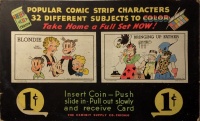Exhibit Card: Difference between revisions
m (→Feature Comics) |
m (→Feature Comics) |
||
| (One intermediate revision by the same user not shown) | |||
| Line 5: | Line 5: | ||
==History== | ==History== | ||
The Chicago-based "Exhibit Supply Company" | The Chicago-based "Exhibit Supply Company" (ESCO) specialized in producing postcard-sized, thick cards from the 1920s through the 1960s. Their range of subjects included movie stars, cowboys, attractive women, baseball players, and various athletes. Unlike typical advertising or product premium cards, ESCO's cards were the product themselves. | ||
=== | Store or arcade owners would purchase ESCO vending machines, and ESCO would supply refill products for these machines. While the vending machines were the means of distribution, ESCO's primary revenue came from the refill orders rather than the sale of the machines. Patrons of the store or arcade could obtain these cards for a penny initially, later increasing to a nickel or dime. | ||
ESCO directly sold refill cards to vendors, and they advertised to arcade owners that they would release a new set of cards, consisting of a minimum of 32 cards, every 60 days. This regular release of new sets ensured continued interest and engagement from patrons, driving ongoing sales for both ESCO and the arcade owners. | |||
===Comics Cards=== | |||
These comics cards were introduced in 1949 and printed in black and white. These cards were specifically designed for collectors to color them in according to their preferences. The set comprised thirty-two cards, each postcard-sized, measuring 8.5x13.5 cm. This format allowed collectors to engage creatively by adding their own colors to the illustrations, making each card unique and personalized. | |||
<gallery> | <gallery> | ||
Image:AEX-1949-01.jpg|"Mister Breger"<br>by Dave Breger | Image:AEX-1949-01.jpg|"Mister Breger"<br>by Dave Breger | ||
| Line 44: | Line 46: | ||
Image:AEX-1949-32.jpg|"Toots and Casper"<br>by Jimmy Murphy | Image:AEX-1949-32.jpg|"Toots and Casper"<br>by Jimmy Murphy | ||
</gallery> | </gallery> | ||
==Note== | ==Note== | ||
In 1949, another series of cartoon cards was released. I this series on find: "The Yellow Kid", "Superman", "Betty Boop", "Dick Tracy", "Little Orphan Annie", "Lil' Abner", "Casper", "Nancy", "Felix the Cat" ''(signed)'' among others. | In 1949, another series of cartoon cards was released. I this series on find: "The Yellow Kid", "Superman", "Betty Boop", "Dick Tracy", "Little Orphan Annie", "Lil' Abner", "Casper", "Nancy", "Felix the Cat" ''(signed)'' among others. | ||
Latest revision as of 11:18, 17 March 2024
 Vending display | |
| Country: | |
|---|---|
History
The Chicago-based "Exhibit Supply Company" (ESCO) specialized in producing postcard-sized, thick cards from the 1920s through the 1960s. Their range of subjects included movie stars, cowboys, attractive women, baseball players, and various athletes. Unlike typical advertising or product premium cards, ESCO's cards were the product themselves.
Store or arcade owners would purchase ESCO vending machines, and ESCO would supply refill products for these machines. While the vending machines were the means of distribution, ESCO's primary revenue came from the refill orders rather than the sale of the machines. Patrons of the store or arcade could obtain these cards for a penny initially, later increasing to a nickel or dime.
ESCO directly sold refill cards to vendors, and they advertised to arcade owners that they would release a new set of cards, consisting of a minimum of 32 cards, every 60 days. This regular release of new sets ensured continued interest and engagement from patrons, driving ongoing sales for both ESCO and the arcade owners.
Comics Cards
These comics cards were introduced in 1949 and printed in black and white. These cards were specifically designed for collectors to color them in according to their preferences. The set comprised thirty-two cards, each postcard-sized, measuring 8.5x13.5 cm. This format allowed collectors to engage creatively by adding their own colors to the illustrations, making each card unique and personalized.
"Mandrake the Magician"
by Phil Davis
Note
In 1949, another series of cartoon cards was released. I this series on find: "The Yellow Kid", "Superman", "Betty Boop", "Dick Tracy", "Little Orphan Annie", "Lil' Abner", "Casper", "Nancy", "Felix the Cat" (signed) among others.
Sources
- Private collection































